
Logan and Albert Conservation Association

How can we better 'protect' koalas in SEQ?
Unless we take actions NOW the days of seeing koalas moving freely in the wild ie open bushland areas are numbered - and reducing daily where people and our human needs do not also consider other species in our "business as usual" daily lives.
That there is no koala chapter in the draft SEQ plan is incomprehensible and totally unacceptable Logan and Albert Conservation Association [LACA] members and Wildlife Logan members believe.
That public display depends on the Koala Inquiry and DEHP's Koala Unit is unacceptable. Regardless of any recommendations from these other bodies our iconic koala and its protection MUST be included in any planning / visionary planning for SEQ and other areas of Queensland where koalas are still surviving.
KOALAS FACE LOCAL EXTINCTION IN LOGAN!
Yarrabilba and Flagstone housing estates high on koala black spot list reports Sarah Orr, from Quest Newspapers January 2, 2017
Australian Koala Foundation chief executive Deborah Tabart says that new housing estates such as Yarrabilba and Flagstone were high on the koala black spot list. These fears echo and re-inforce the worst fears of the Logan and Albert Conservation Association and local group Logan Community Environment Watch.
Ms Tabart was pushing for a freeze on habitat clearing. She said koalas in Logan were “functionally extinct” meaning the population may never recover.
“I’ve seen committee after committee and the core problems don’t go away because we keep cutting habitat down,” she said.
“The Queensland Government will never impose constraints on the developer because that’s where they get their money.” She said she was not surprised rescue groups reported their “worst season ever” for deaths and injuries.
Habitat loss seems to be increasing daily with the planned $750 million southeast Queensland resort complex to be built by a Chinese property developer in a koala habitat area seeks permission to increase its approved 500-unit project on the site to 1500 units.
The areas of proposed clearing for human settlement continues with the most recent application by MIRVAC at Greenbank East
Development, dogs, disease and car hits behind koala crash - add to that people.
Media has many articles / reports about the state of koalas in South East Queensland - especially Redlands
Our petition SIGN IT HERE
TO: THE HONOURABLE GREG HUNT, MP, FEDERAL MINISTER FOR THE ENVIRONMENT

PROTECT KOALAS AND QUOLLS
Ask Federal MP Greg Hunt to
SAY NO TO INDUSTRY AT NORTH MACLEAN
Dear Minister Hunt,
Please reject the development application for the proposed North Maclean Enterprise Precinct at North Maclean, South-East Queensland which involves clearing 289 acres of koala and quoll habitat.
Why is this important?
There are significant environmental and community concerns
ENVIRONMENTAL CONCERNS Sign to support our petition here
Since 1996, the environmental concerns raised by the community at North Maclean and Munruben have never been addressed. There have been numerous sightings of vulnerable Koalas on and around the property. There have been numerous sightings of endangered Spotted-Tailed Quolls in adjacent properties - these quoll sightings have been the first in the Greater Brisbane Area since the 1930s . Quoll roadkill has been collected from the area confirming the presence of quolls in this area. The proposed site provides valuable habitat for koalas, quolls and other threatened species including the endangered grey headed flying fox, the Swift Parrot and the vunerable Glossy Black Cockatoo.
There have been no detailed impact assessments of industry on these vulnerable/threatened species. No frog or reptile studies have ever been carried out.
By signing the petition, you are asking Minister Greg Hunt to REJECT the North Maclean Enterprise (Industry) Precinct proposal. You will be giving our unique Koalas, Spotted-tailed Quolls and other Endangered/Vulnerable wildlife of North Maclean and Munruben a chance of survival. If this development application is approved at North Maclean, 117 hectares (approx. 289 acres) of koala food and shelter habitat will be totally cleared. The major threat to koalas is the loss of habitat. This vast proposed site is only 45% of what is eventually planned for the koala habitat of North Maclean. This current application is a dangerous precedent in the area that should not be approved.
COMMUNITY CONCERNS Sign to support our petition here
Driving koalas to extinction
Motorists need to be aware that koalas are especially on the move now during mating season and keen to cross the road to seek a mate. We must be even more alert and on the lookout for animals and their young on the roads.
Koala sightings as well as fatalities are being reported in Queensland and New South Wales. The death of a female and her joey is a double tragedy.
Albert and Logan News September 27, 2014 published a strory featuring Australian Koala Foundation AKFSeptember 27, 2014 published a strory featuring Australian Koala Foundation AKF highlighting the need for new and protective legislation.
Article will be continued
TIME IS RUNNING OUT FOR OUR KOALAS - submissions close 5pm 7 February 2014
TAKE ACTION HERE Quick online submission via IFAW can be sent via this link
So concerned for koalas is the International Fund for Animal Welfare IFAW they have an online petition to Peter Wright Director, Species Information and Policy Section, Department of Environment concerning the Draft EPBC Act referral guidelines for koalas.
LACA Logan and Albert Conservation Association agrees with IFAW's conclusion that
If the government's Koala Referral Guidelines get the green light, it will legalise the destruction of vital koala habit. We urgently need your help as the 7th February deadline to prevent further koala deaths is looming. Let’s find a way to stop the bulldozers.
The latest proposed 'referral guidelines' are just another nail in the coffin, putting profit before protection. We need your help to let the Government know that this approach isn't good enough and that they must do much more if we are to save this precious Aussie icon.
Please write to the Government today making your views known. IFAW have drafted a submission the text follows below.
I am writing to you as an Australian animal lover to express my deep concern about the draft referral guidelines for koalas (combined populations of Queensland, New South Wales and the Australian Capital Territory).
These draft guidelines are not robust enough to ensure that potentially damaging developments are submitted for referral and scrutiny.
• Many areas important to the survival of koalas in urban and semi-urban areas are deemed not to need referral.
• The scoring system for determining which koala habitats are referred is flawed, with only habitats achieving high scores of 8+ needing to be referred, ignoring those still critical koala habitats that may not make the grade.
• Cumulative impacts have been completely ignored.
These draft guidelines would potentially allow extremely risky and damaging developments to proceed without proper assessment and without the opportunity for community or public scrutiny and consultation. This is a recipe for the continued demise of koala populations.
The threatened species referral measures under the EPBC Act need to be applied with rigour and a high degree of precaution and priority if they are to have any impact in protecting koalas. These guidelines are a step in the opposite direction – opening the door for unsustainable development to destroy habitats vital for koala survival.
As a priority a robust National Recovery Plan for the koala must be developed and implemented. This must include follow-up mechanisms to guarantee the continuation and improvement of coordinated management and conservation efforts for the species, ensuring that the populations not covered by the EPBC Act also are considered.
Australian Koala Foundation has also condemned the Draft EPBC Act referral guidelines for koalas.
You can read more from AKF here
Save the koala media release is scathing of the guidelines and their intention ending
“We have little faith that the EPBC Act or these guidelines will achieve much for the Koala. Indeed the only reason we have made this submission is to ensure our position is on the record. The only way to achieve true protection for the Koala will be to get the Koala Protection Act passed in Federal Parliament. And we will,” says Tabart.
Time is short but a short submission is all that is needed.
Guidelines website linked here states "These draft guidelines have been developed in consultation with Koala experts, ecological consultants and state government representatives. The public comment period provides an opportunity for wider consultation with stakeholders. Feedback is welcomed on all aspects of the guidelines and all comments received will be considered in the finalisation of this document."
Comments may be submitted in an Excel, Word or PDF format. Comments must be submitted to:
Email: This email address is being protected from spambots. You need JavaScript enabled to view it.
See also what Wildlife Queensland had to say about the guidelines - concluding
However, is it too little, too late? The Government at all levels has known what to do to ensure a sustainable coexistence between koalas and humans for decades, yet has chosen instead to prioritise anthropological development over the protection of prime koala habitat and the preservation of a national icon. Wildlife Queensland lives in hope that appropriate action will be taken before it is too late. Our children’s children should have the right to view the koala in the wild.
Logan media release published 19 July 2013
Keep Your Eyes Peeled For Koalas This October
Any sighting can be reported to Logan Council either on
3820 1103
or at logan.qld.gov.au/wildlifesightings
Logan residents are being encouraged to keep an eye out for koalas during an annual community koala survey.
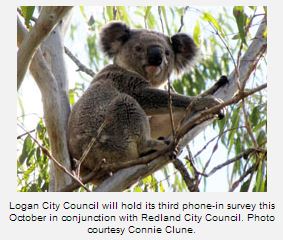
Health, Environment and Sustainability Committee Chair Cr Trevina Schwarz said the weekend was about raising awareness of the region's most iconic residents and the importance of maintaining koala habitat corridors across the city.
"We know that koalas inhabit many areas within Logan City and it is essential that we continue to build our knowledge of their distribution and numbers," she said.
"During the sighting period, residents are asked to note down the locations and times of sightings and then report them to Council by phone or through Council's website.
"We urge residents to report as much information as they can – from size, location, health, behaviour, sex and species of tree; a photograph is also useful.
"While koalas do tend to spend most of their days asleep in trees or grazing, spring time is also mating season and they can be expected to be a little more active than usual – keep an ear our for their distinctive grunts at all hours of the day."
Cr Schwarz said the survey, now in its third year in Logan, was a good way to gather information on koala distribution not just in Logan but across the region.
"It's important that we make sure we regularly build a snapshot of koala distribution across the city to understand movement patterns and try to help manage urban growth across the city," she said.
"We are also partnering with Redland City Council, Moreton Bay Regional Council and the Koala Action Group to conduct surveys on the same day in an effort to build some regional information on koala movements between cities.
"This information is added to Council records and will assist with refining future whole of city koala population.
"Conservation isn't just for zoos, it's something we can all play a part in, even by just looking up during your morning bush walk or keeping an eye out when working on your property.
"I strongly encourage all residents to mark the weekend in their calendars and start to keep an eye out for koalas in their communities."
Any sighting/s can be reported to Council either on 38201103
or online at logan.qld.gov.au/wildlifesightings.
Koala hotspot in Logan is Berrinba Sanctuary at Browns Plains. See regular posting on their Facebook page
https://www.facebook.com/pages/Berrinba-Sanctuary/326254244157209?hc_location=timeline Click to see some of the latest photos.
Koalas face carnage as loggers harvest timber plantations
Although the logging industry has claimed contractors were not deliberately hurting koalas, it is understood in some circumstances koalas are being knocked from trees, squashed and caught up in mechanical shredding machinery.
Where are the koala / wildlife spotters to check that each and every tree that is to harvested does not have a rsident koala? Are there no protocols to ensure safety of all wildlife?
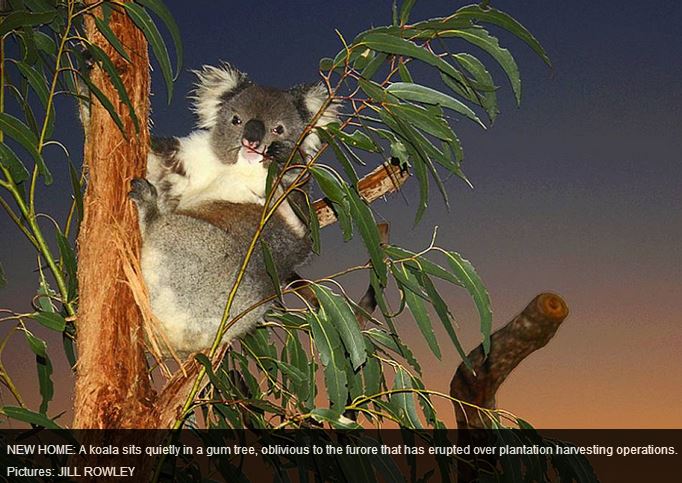 It is understood when the sprawling bluegum estates were planted around 15 to 20 years ago, there was little knowledge the hardwood plantations would become a significant refuge and a new food source for koalas.
It is understood when the sprawling bluegum estates were planted around 15 to 20 years ago, there was little knowledge the hardwood plantations would become a significant refuge and a new food source for koalas.
However when you have a plantation of known koala habitat trees then surely it must signal strong possibility that koalas would move in to enjoy young green leaves? Koalas do not eat all gums. In fact of over 700 species of eucalypts koalas eat less than 20 species of gums!
According to a national academic, the issue is also now becoming a global issue given koalas are an "international icon". Koala expert Dr Stephen Phillips, who is a member of the Federal Government's Koala Abundance Working Group, said the emerging situation was "unfortunate" given the plantation estates were the way of the future and important economically for regional communities.
"They have a right to harvest, I certainly wouldn't like to see that change, that would be ridiculous," Dr Phillips said.
As with all of our industry rights, they must adapt to changing conditions. All timber plantations must be grown and harvested sustainably - that means not only in the fastest manner for greatest profit but with regard for all uses and users of the forest.
We thank the whistleblowers for alerting us to the blatent disregard the industry has shown for our native wildlife and exposing the horrendous animal cruelty to the iconic koala and other wildlife in the plantations. Australian Broadcasting Corporation, ABC ,Broadcast: 22/07/2013 with Reporter: Greg Hoy contains some graphic images and sounds of distressed koala. Watch here http://www.abc.net.au/7.30/content/2013/s3808542.htm. Transcript is also available of the interview.
Across the centre and south-west of Victoria and in South Australia, we, ABC, visited many volunteer animal refuges struggling without help from industry or government to cope with casualties.
TRACEY WILSON: Broken limbs, impact wounds, broken backs, severed arm. Dead mothers with joeys that are still alive, trying to survive. I had one 500 gram joey, about this big (demonstrates size with hands) that had two healed broken arms. And so we can only assume from that that the mother had been dropped previous to this incident and she had no obvious breaks, but her intestines were just pulp.
Koala carers have rescued and saved many - only to be released - as required - back in close proximity of plantation.
The cost of care and rehabilitation for rescued koalas is carried by volunteer not for profit groups.
Why shouldn't industry pay?
All existing koala habitat is essential for the future well being of Logan's resident koala population. And importantly all populations contribute to the genetic pool for the species and wide diversity is a potential safe guard in the event of a disaster such as bushfires which can deplete a koala population in that area. Though LACA Logan and Albert Conservation Association is advocating here for the iconic koala, this is an umbrella species for all. Without the flying fox - pollinator of eucalypts - only food source for the koala the fate of the koala is not certain. Tree clearing changes introduced by Newman government will we fear have dire consequences
Long term advocate for all environmental issues Barry Fitzpatrick has had an article published in Albert and Logan News. We thank them for publishing our concerns. If you also are concerned make sure that all your elected representative know. Use media eg comment on article in letter to editor, phone write email your local member - at all 3 levels of government.
Importantly also - REPORT ANY and ALL KOALA SIGHTINGS.
Meet Alex Harris at Berrinba Sanctuary open day 15 December 2012.
If you are new to becoming engaged in helping to save Australia's iconic koala you may not yet know the name. She is responsible for developing an amazing online website and tool to allow citizen scientists all over Australia to record their sightings. Come along to Berrinba Sanctuary open day 15 December 2012 and meet her and hear first hand about Koalatracker which is Australia's first national crowdsourced koala map.
This amazing tool has been provided for us all to use. So lets all become KoalaTrackers so we can report koala sightings, view the koala map, view member photo galleries, use resources and search the database to learn more about koalas in our area and more.
CLICK HERE OR ON IMAGE ABOVE TO GO TO THE WEBSITE. Also provided there are phone numbers for sick or injured koalas.
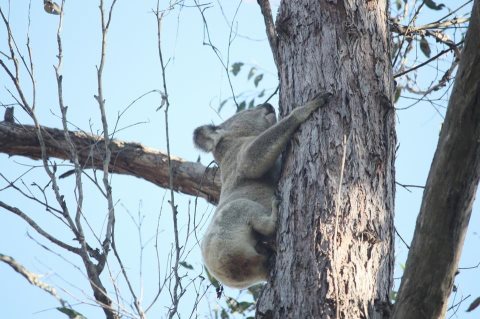 Six koalas were spotted at Berrinba Sanctuary during the koala count day and reported as far away as South Australia where their GREAT KOALA COUNT is planned for Novenber 28. Also check their FACEBOOK page for more information. The koalas in South Australia are larger than Queensland koalas and have different genetics.
Six koalas were spotted at Berrinba Sanctuary during the koala count day and reported as far away as South Australia where their GREAT KOALA COUNT is planned for Novenber 28. Also check their FACEBOOK page for more information. The koalas in South Australia are larger than Queensland koalas and have different genetics.
The image aside was taken outside the survey days.
A mother and its young and 2 males were identified indicating a healthy breeding koala colony.
90 hectares of pristine koala habitat with a healthy population is an environmentally significant biodiversity asset for Logan City and indeed the world.
This property is adjacent to Berrinba Wetlands which, according to Logan City Council is being preserved by design with 80 of 120 hectares being protected and rehabilitated. While Council's intentions here may be commendable it is disconcerting that future planning for the adjacent 90 hectares of natural bushland - having the same or more environmental values is not so fortunate.
It is of great concern to our conservation group Logan and Albert Conservation Association LACA that most planning is done without adequate knowledge of the biodiversity and ecosystem services present across the landscape. It is also disconcerting that landscapes without human habitat - greenfield areas, are regarded as available for development. To have a major freight motorway dissect koala habitat is untenable.
Such is the case for Berrinba Sanctuary. The HUMANE SOCIETY INTERNATIONAL (HSI) / Wildlife Land Trust (WLT) recently added the Browns plains property to those other properties being managed as WILDIFE SANCTUARIES - 47 in Queensland covering19,947 hectares.
Some of the values and biodiversity present at Berrinba Sanctuary are available at this page. The longterm survival of this group of koalas is vital to the survival of koalas in Logan and Southest Queensland.
What are your / our values and vision for Logan? Do they include natural landscape areas - connected across the lanscape for safe animal movement - or are we letting someone else decide for us? If we are not mindful then we are in danger of having our paradise paved.
COUNT KOALAS 20-21 October 2012
Do you have some time to spend in the bush this weekend. Join community members out looking for koalas. There is little as thrilling as seeing a koala in a bushland setting behaving as a koala.
If you looking during the day then probably most koalas will be sleeping - high up, in any tree.
Council asks What is Council Doing? but although Council would have us believe it intends to protect koala habitat and that Council has secured large areas of bushland where koalas are common, and vegetation protection and appropriate land zonings are in place to protect those areas, this is not the perception of those of us who monitor / watch Council's development plans. There have been no studies / research in the amalgamated areas and even large bushland properties in private ownership. More about that in other articles.
REPORTING ALL YOUR WILDLIFE SIGHTINGS IS IMPORTANT BUT ESPECIALLY KOALAS THIS WEEKEND. Council has an online reporting form for you to use which you locate at this link.
If you prefer you can phone 3820 1103 between 8am and 5pm to report your sightings or even if you identify the koala by its distinctive sound. Listen to a recording of a male koala bellow here. Logan and Albert Consevation Association president Anne Page will be one of volunteers manning the phones and she would love to hear from you.
Check out map council has provided here. Here we can see a smattering of red dots for recorded sightings across all suburbs. Longterm survival of these koalas depend on - at a minimum - connectivty and preservation of wildlife corridors - established by animal movements, green infrastructure being included in any roads, driving alertly, and improved control of our domestic animals especially dogs
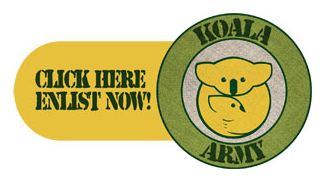 The KOALA ARMY NEEDS US ALL. ENLISTING is easy.
The KOALA ARMY NEEDS US ALL. ENLISTING is easy.
Support this action from Australian Koala Foundation. Go to the following linked page https://www.savethekoala.com/koala-army/send-letter and using information provided there, send a letter to your politicians. Phone them also for extra emphasis. Spread the word with your friends and family. Let them know you are joining the Koala Army to ask for a Koala Protection Act. This is especially inportant as our current legislation and policies have failed and will continue to fail to protect the koala's essential habitat.
It is particularly worrying that big business has had the government's ear and through COAG there are plans to give the EPBC Act 'powers' to state governments.
You might also like to go to the koala army shop to purchase a dog tag or army tee shirt?
 September is month allocated to Save the Koala Month, the annual awareness and fundraising initiative of the Australian Koala Foundation AKF. This year Donation Boxes will be on counters for you to donate at your local Newsagents, CUA branches and other outlets across Australia. However, this won't be enough, KOALAS, AKF and LACA need your help. We need people to order a donation box and place on a counter at your work, local gym or school.
September is month allocated to Save the Koala Month, the annual awareness and fundraising initiative of the Australian Koala Foundation AKF. This year Donation Boxes will be on counters for you to donate at your local Newsagents, CUA branches and other outlets across Australia. However, this won't be enough, KOALAS, AKF and LACA need your help. We need people to order a donation box and place on a counter at your work, local gym or school.
Alternatively you can hold a fundraising event to help save koalas. Contact The AKF for advice and support.
All funds raised during the month of September will go directly to the instatement of the 'National Koala Act', a one-page piece of legislation which basically says:
"You cannot harm it, you cannot harm its joey and you cannot harm its habitat."
The AKF believes this is the only way to fully protect the koala and to stop the decline of koala numbers in the wild. LACA agrees that without protective legislation, koala populations will decline. Management Plans alone will not work as they include offsetting and mitigation. Great policy must be supported with legislation.
YOU CAN HELP by joining the AKF KOALA ARMY and by writing a letter. This page https://www.savethekoala.com/koala-army/send-letter has a sample letter and contact details for state and federal ministers. You can also talk to your local members.
We must all do our bit to keep a healthy koala population in the wild. Survival in a zoo must not be the fate of our national icon the koala.
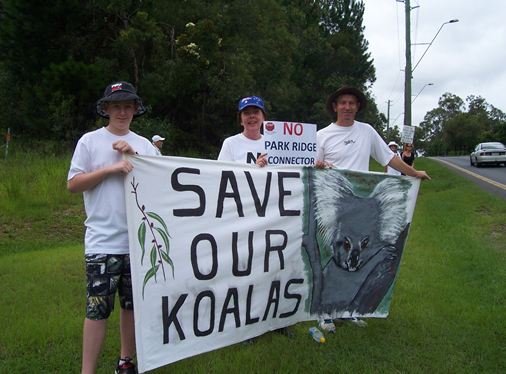
What a dismal future is "planned" for our koala populations in SEQ!
LACA members would agree with Federal Environment Minister Tony Burke's statement that "the states on their own have allowed numbers to continue to go into freefall." While this rapid decline in numbers may be attributed to development, cars, dogs, disease and climate change the real picture must also include the lack of political will to make decisions and legislation that will be loudly opposed by the development industry. The decades of work done by the Australian Koala Foundation - funded by community was instrumental in the EPBC protection coming about.
The image above shows community protest outside property DTMR wants to acquire to build a road freight motorway - called Park Ridge Connector Corridor. This property is currently shared with resident koalas and other species. It also shares many species and values of Berrinba Wetlands and Karawatha Forest.
Why would government want to pave any of this?
We - ie all governing bodies and communities of people who share koala land - need to preserve all koala habitat currently used - and take preventative action to retain the ecosytem containing the food trees. The mantra NO TREE NO ME is absolutely true.
It is a shameful indictment on the Gold Coast city that the Coomera development has occurred. The so called scientific research re translocation is a furphy to obtain funding. It does not justify clearing koala habitat to build houses and infrastructure for people! To make matters worse Gold Coast council has recently decided to place a protection order on two camphor laurel trees - an environmental weed species. What persuaded them? Someone chained to a tree for two days.
 Australia's most at-risk populations of koalas (Phascolarctos cinereus) – those in Queensland,New South Wales and the Australian Capital Territory - are now protected under national environment law. These FAQs have been developed to inform industry, developers, landholders and landowners.
Australia's most at-risk populations of koalas (Phascolarctos cinereus) – those in Queensland,New South Wales and the Australian Capital Territory - are now protected under national environment law. These FAQs have been developed to inform industry, developers, landholders and landowners.
CLICK ON IMAGE to read about the listing and associated reports from federal government. After considering scientific advice from the Threatened Species Scientific Committee, Environment Minister Tony Burke has listed the Queensland, New South Wales and Australian Capital Territory koala populations as vulnerable under national environment law.
The world is watching us in Australia to see whether we as a people, a nation, can save our iconic koala from extinction in all its local habitats. Unfortunately while we have many carers and wildlife support systems to rescue injured and sick koalas and save many to be rehabilitated there are as many individuals businesses and corporations that do not respect the values of habitat for wildlife - insisting that the financial costs of accommodating koala habitat is not an option.
The Australia government's declaration of partial protection under the EPBC Act is a small and hard won victory for the local and global conservation movement. 95% of South East Queensland's natural koala habitat is now gone as a result of land clearing that's making way for new urban dwellings to keep up with what is Australia's fastest growing region. Operation bulldozer has been in place and our new state government under leadership of Campbell Newman is not happy with federal legislation slowing down development in Queensland.
Referral to the federal environment minister however will only be required if a development or action is likely to result in a significant impact to koala populations or their habitat. This is guided by relevant EPBC Act Significant Impact Guidelines, including specific Koala Significant Impact Guidelines which are currently being prepared.
Every species requires food to survive and for the koala their diet is restricted to a narrow range of eucalyptus trees. Not all gums are a food source and even koalas have their favoured trees - developed from the supply in their home range. The legislated requirement to return koalas their home range is a challenging one as ever more habitat has been cleared for human housing and asociated services or infrastructure.
May edition of National Geographic magazine feaures the hazards of being a koala in South East Queensland and the dedication that some of our koala heroes provide to rescue as many koalas as possible. Extracting a koala from barbed wire fencing in dark early hours of morning, scaling tall trees to monitor koala movement and sharing one's house with recouperating koalas are some tasks gladly tackled - and freely - to help our endangered koala population. Deidre de Villiers is one of these people.
Learning to live in harmony with our local koalas - be they urban or rural is critical for their survival. LACA is firmly committed to the belief that this is not only possible but essential. Deidre was one of our speakers where we presented ways to work towards achieving this.
It is unfortunate that that sector of our community who see faster development as part of their business model feel threatened by new federal legislation. Our fast society - fast food, fast money, fast cars, fast development - does not connect with life in a slower lane where nature can be appreciated. We who connect with and care about the natural world and its species have an important role to play to rescue the koala from extinction. The determination of Debbie Tabbard of the Australian Koala Foundation, the community support for Australia Zoo and Currumbin Wildlife Sanctuary in Queensland, the many nameless volunteers carers, landcare groups, organic farmers, scientists and researchers has been rewarded with federal legislation as a first real step to slowing the road to extinction.
As caring citizens we need to be watchdogs for compliance. We have also to network in our local communities and with local and state government agencies to create a better understanding of the value of biodiversity and functional healthy ecosystems.
Mr Burke's announcement includes some small but inadequate funding. The video clip linked here alerts us to the unsatisfactory "solution" of offsetting to allow a development to proceed. To date LACA's experience of offsetting has not occurred in local area concerned, has not benefited endangered target group and has not improved any corridors to allow koalas to move independantly. In addition if such offset are nor established pre-clearing they will not be a viable food source for the endangered local koalas.
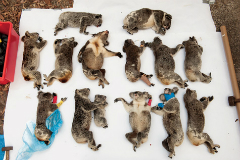 The Australian icon - the koala - is on the brink of extinction in its native bushland habitats. National Geographic photographer Joel Sartore took the photo shown in this article. Such a weekly death rate is unsustainable and will lead to the demise of our koalas outside of captive breed specimens in zoos - like China's panda bears.
The Australian icon - the koala - is on the brink of extinction in its native bushland habitats. National Geographic photographer Joel Sartore took the photo shown in this article. Such a weekly death rate is unsustainable and will lead to the demise of our koalas outside of captive breed specimens in zoos - like China's panda bears.
Koala populations that used to be vibrant and sustainable are facing local extinction. Inadequate government legislation is to be held acountable for this. Queensland has failed to do anything meaningful about the decline. Whether the newly elected government will improve the odds for koalas remains a question. The federal government needs to get involved and do it properly, listing the koala as vulnerable to extinction. Such a designation might save the last remnants of critical koala habitat. Without habitat to provide a local food source the plight of the koala is bleak.
A recent report presented to the Australian Senate made several recommendations to save the koalas, including
All are essential and critical. Meanwhile local koala care groups in eastern Australia struggle to rescue rehabilitate and release recovered animals. Legislation requires that the koala is returned to its home range - a challenging exercise when widespread clearing for human settlement has occurred - or mining. The efforts of grassroots koala emergency squads will always be essential but individual carers must also be supported for expenses incurred.
The more koalas we lose, the more valuable each rescued koala becomes. The May edition of National Geographic relates some of the extraordinary challenges faced and meet by koala rescuers carers and local research people such as Deidré de Villiers who shares her home with recovering adults juveniles or dependant joeys. You can read their story here. Deidre has presented at past Logan and Albert Conservation Association workshops about learning to live harmoniously with koalas and other wildlife. It is possible if we are prepared to make some adjustments to the way we currently go about our daily lives.
New partnership for wildlife carers
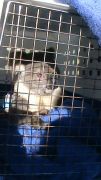 This koala was rescued on 5 October 2011, and taken to Daisy Hill Koala Sanctuary. He was euthanased at Moggil Hospital due to his being blind (from having had conjunctivitus and cystitis) and not having a suitable habitat to be released. He was 6 years old. Apparently if his habitat was denser he would be fine to survive as they usually rely mainly on smell and hearing (in a koala with normal sight). They do release koala's that are blind.
This koala was rescued on 5 October 2011, and taken to Daisy Hill Koala Sanctuary. He was euthanased at Moggil Hospital due to his being blind (from having had conjunctivitus and cystitis) and not having a suitable habitat to be released. He was 6 years old. Apparently if his habitat was denser he would be fine to survive as they usually rely mainly on smell and hearing (in a koala with normal sight). They do release koala's that are blind.
Image aside is one of the photos of the koala "rescued" by a local wildlife carer.
The new partnership between DERM and RSPCA ,Qld and the carer network would strengthen the overall care of wildlife in Queensland by combining resources and providing a united approach. RSPCA Qld and DERM have driven this change to improve coordination and response times, and reduce the time that animals are in distress according to Mr Bradley from RSPCA
The change to 1300 ANIMAL means the caller will speak directly to an experienced RSPCA Qld operator who will arrange an appropriate response. The partnership covered various aspects of the management and regulation of protected wildlife rescue, care and rehabilitation.
The new arrangements will be trialed for 12 months from 1 September, and DERM has contributed $60,000 to support the improved response and the RSPCA's package of improved networking, training and communication for the wildlife carer network. DERM will still be responsible for issuing wildlife rehabilitation permits.
The care and rehabilitation of sick, injured and orphaned wildlife is delivered through a dedicated volunteer network of licensed wildlife carers throughout Queensland. RSPC Qld currently has approximately 400 'wildlife heroes' who are available to conduct the rescue of sick, injured or orphaned animals and who support wildlife carers and that number is set to increase following a recruitment drive.
DERM ensures that wildlife care is done according to best practice and meets the expectations of the broader community through a Code of Practice for carers.
Read that code here. I have some reservations about the code. Hopefully there will be an open review after 12 month trial period.
You can see the presentation delivered to wildlife carers here. New partnership for wildlife care information is here
The greatest threat to our local koalas in the LACK OF POLITICAL WILL TO CREATE LEGISLATION TO PROTECT THEIR HABITAT.
 The Save Our Koalas rally held in Brisbane City on Friday 25th September 2009, Save the Koala Day was a great turnout! Many said there were over 1000 people on the streets. Fantastic! We were inspired by the effort made by everyone on the day and just how many passionate people there were willing to let our Governments know that we've had enough and want our Koalas protected. That message was tabled in Parliament on Thursday 8th October 2009 by Mr. Glen Elmes, state Shadow Minister for the Environment. As usual there is silence from our politicians at both the State and Federal levels.
The Save Our Koalas rally held in Brisbane City on Friday 25th September 2009, Save the Koala Day was a great turnout! Many said there were over 1000 people on the streets. Fantastic! We were inspired by the effort made by everyone on the day and just how many passionate people there were willing to let our Governments know that we've had enough and want our Koalas protected. That message was tabled in Parliament on Thursday 8th October 2009 by Mr. Glen Elmes, state Shadow Minister for the Environment. As usual there is silence from our politicians at both the State and Federal levels.
It is now up to us collectively to keep the pressure on our Governments to act and act now!
On 10 November 2009, scientists from around Australia will meet to decide on the Australian Koala Foundation's nomination of the koala as ‘vulnerable' under the EPBC Act, Australia's threatened species legislation. If the Koala is protected then it will mean that all developments in koala habitat will have federal oversight, something that hasn't happened since white settlement 200 years ago.
So what can you do?
 Residents are asked to participate in the Logan City Council's phone-in and web-based community koala survey on Saturday 22 and Sunday 23 October 2011
Residents are asked to participate in the Logan City Council's phone-in and web-based community koala survey on Saturday 22 and Sunday 23 October 2011
Report Your Wildlife Sightings here
Council would appreciate any sightings (or evidence) of threatened or locally significant wildlife you may have encountered in Logan, by submitting the following sighting details. You may also provide records of any deceased animals, such as roadkill animals, as this information is also important.
For the phone-in survey, please call 07 3820 1103 between 8am and 5pm to record your sightings from the weekend.
Information that we will be collecting on the day includes sex, health, location, behaviour and the trees species in which it is located. This information will help us obtain local data about koala distribution and inform planning and management. Of course if you do not know all of this, LOCATION is most important - other details help paint a better picture.
Thanks for helping with wildlife sightings - at all times.
The koala in the image above Babe was rescued from dogs in the Jimboomba area 2009. Legislation requires the koala to be released in the same general area after recovery. Read some of Babe's story here.